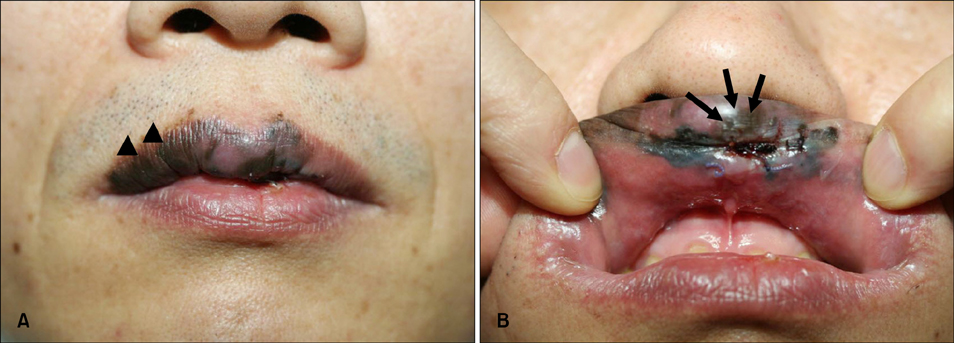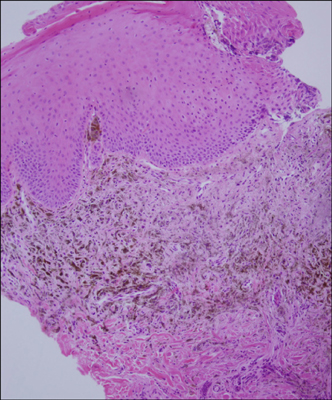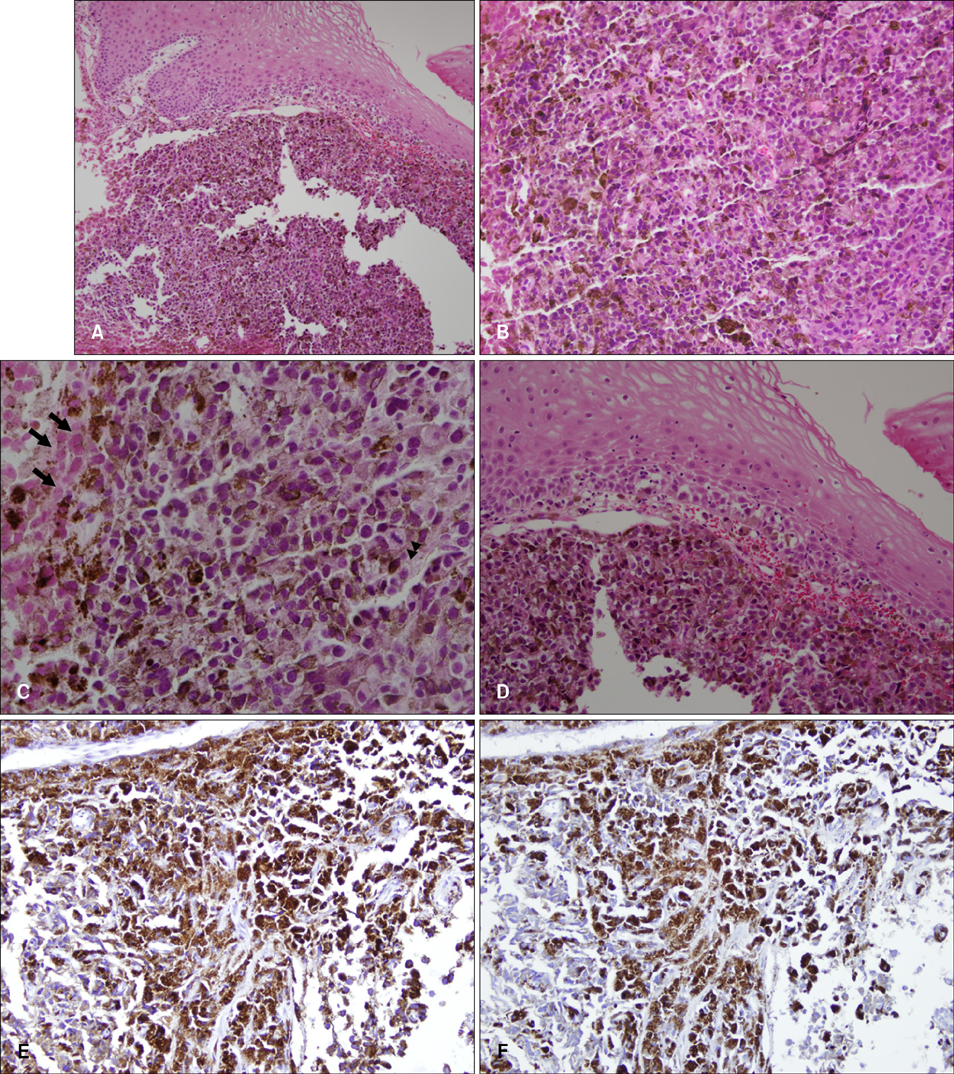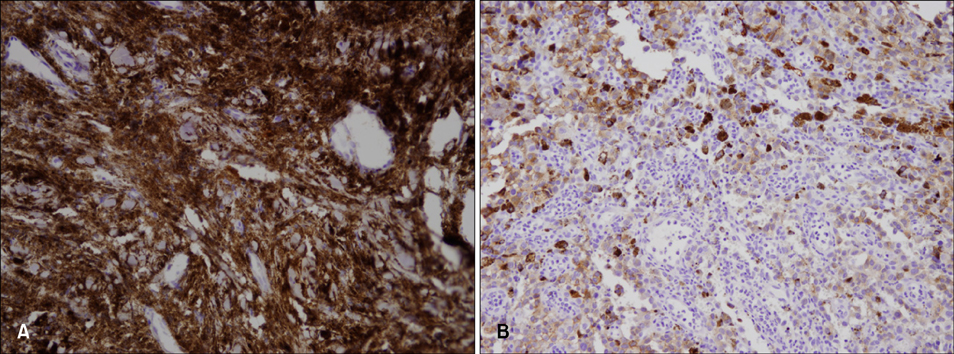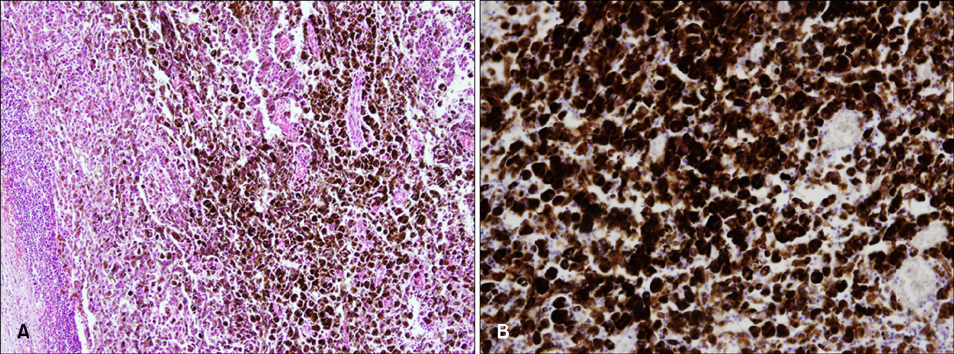Ann Dermatol.
2010 Feb;22(1):119-124. 10.5021/ad.2010.22.1.119.
A Malignant Melanoma Associated with a Blue Nevus of the Lip
- Affiliations
-
- 1Department of Dermatology, Gachon University of Medicine and Science, Gil Hospital, Incheon, Korea. jyroh@gachon.ac.kr
- KMID: 2172056
- DOI: http://doi.org/10.5021/ad.2010.22.1.119
Abstract
- Blue nevi are characterized by a collection of pigment-producing melanocytes in the dermis. These lesions clinically present as well demarcated cerulean-blue or bluish black colored papules or plaques that usually measure less than 1 cm in diameter. They are typically found on the dorsal surface of the hands and feet or in the head and neck region; however, they are rarely found in the oral cavity. These lesions are usually benign and stable over time. However, malignant melanomas developing in or associated with a blue nevus (which is also called malignant blue nevus) have been only rarely reported. A malignant blue nevus might develop in a common blue or cellular blue nevus, a giant congenital nevus or in a nevus of Ota, or it may be malignant from the start. Malignant blue nevi most commonly are found on the scalp. A malignant blue nevus of the lip has not been previously reported in the medical literature. We report here on a patient with a malignant melanoma associated with a blue nevus of the lip. The malignant melanoma was presumed to have developed from a blue nevus that was present on the upper lip of a 50-year-old male.
MeSH Terms
Figure
Reference
-
1. Fistarol SK, Itin PH. Plaque-type blue nevus of the oral cavity. Dermatology. 2005. 211:224–233.
Article2. Granter SR, McKee PH, Calonje E, Mihm MC Jr, Busam K. Melanoma associated with blue nevus and melanoma mimicking cellular blue nevus: a clinicopathologic study of 10 cases on the spectrum of so-called 'malignant blue nevus'. Am J Surg Pathol. 2001. 25:316–323.
Article3. Meleti M, Mooi WJ, Casparie MK, van der Waal I. Melanocytic nevi of the oral mucosa - no evidence of increased risk for oral malignant melanoma: an analysis of 119 cases. Oral Oncol. 2007. 43:976–981.
Article4. Buchner A, Leider AS, Merrell PW, Carpenter WM. Melanocytic nevi of the oral mucosa: a clinicopathologic study of 130 cases from northern California. J Oral Pathol Med. 1990. 19:197–201.
Article5. Scotto J, Fraumeni JF Jr, Lee JA. Melanomas of the eye and other noncutaneous sites: epidemiologic aspects. J Natl Cancer Inst. 1976. 56:489–491.
Article6. Saida T, Kawachi S, Takata M, Kurita H, Kurashina K, Kageshita T, et al. Histopathological characteristics of malignant melanoma affecting mucous membranes: a unifying concept of histogenesis. Pathology. 2004. 36:404–413.
Article7. Hu W, Nelson JE, Mohney CA, Willen MD. Malignant melanoma arising in a pregnant African American woman with a congenital blue nevus. Dermatol Surg. 2004. 30:1530–1532.
Article8. Pathy AL, Helm TN, Elston D, Bergfeld WF, Tuthill RJ. Malignant melanoma arising in a blue nevus with features of pilar neurocristic hamartoma. J Cutan Pathol. 1993. 20:459–464.
Article9. Hagiwara T, Kaku T, Kobayashi H, Hirakawa T, Nakano H. Coexisting vulvar malignant melanoma and blue nevus of the cervix. Gynecol Oncol. 2005. 99:519–520.
Article10. Barnhill RL, Argenyi Z, Berwick M, Duray PH, Erickson L, Guitart J, et al. Atypical cellular blue nevi (cellular blue nevi with atypical features): lack of consensus for diagnosis and distinction from cellular blue nevi and malignant melanoma ("malignant blue nevus"). Am J Surg Pathol. 2008. 32:36–44.
Article11. Mones JM, Ackerman AB. "Atypical" blue nevus, "malignant" blue nevus, and "metastasizing" blue nevus: a critique in historical perspective of three concepts flawed fatally. Am J Dermatopathol. 2004. 26:407–430.
Article12. Elder DE, Elenitsas R, Murphy GF, Xu X. Elder DE, Johnson BL, Elenitsas R, editors. Benign pigmented lesions and malignant melanoma. Lever's histopathology of the skin. 2009. 10th ed. Philadelphia: Lippincott Williams & Wilkins;701–704.13. Zyrek-Betts J, Micale M, Lineen A, Chaudhuri PK, Keil S, Xue J, et al. Malignant blue nevus with lymph node metastases. J Cutan Pathol. 2008. 35:651–657.
Article14. Gontier E, Cario-Andre M, Vergnes P, Bizik J, Surleve-Bazeille JE, Taieb A. The 'Abtropfung phenomenon' revisited: dermal nevus cells from congenital nevi cannot activate matrix metalloproteinase 2 (MMP-2). Pigment Cell Res. 2003. 16:366–373.
Article15. Isabel Zhu Y, Fitzpatrick JE. Expression of c-kit (CD117) in Spitz nevus and malignant melanoma. J Cutan Pathol. 2006. 33:33–37.
Article16. Natali PG, Nicotra MR, Winkler AB, Cavaliere R, Bigotti A, Ullrich A. Progression of human cutaneous melanoma is associated with loss of expression of c-kit proto-oncogene receptor. Int J Cancer. 1992. 52:197–201.
Article17. Montone KT, van Belle P, Elenitsas R, Elder DE. Protooncogene c-kit expression in malignant melanoma: protein loss with tumor progression. Mod Pathol. 1997. 10:939–944.18. Willmore-Payne C, Holden JA, Tripp S, Layfield LJ. Human malignant melanoma: detection of BRAF- and c-kit-activating mutations by high-resolution amplicon melting analysis. Hum Pathol. 2005. 36:486–493.
Article19. Connelly J, Smith JL Jr. Malignant blue nevus. Cancer. 1991. 67:2653–2657.
Article20. Aloi F, Pich A, Pippione M. Malignant cellular blue nevus: a clinicopathological study of 6 cases. Dermatology. 1996. 192:36–40.
- Full Text Links
- Actions
-
Cited
- CITED
-
- Close
- Share
- Similar articles
-
- Two Cases of Common Blue Nevus with Satellite Lesions
- A Case of Common Blue Nevus with Malignant Melanoma-Like Satellite Lesions
- Three Cases of Malignant Melanoma Possibly Arising in a Long Standing Melanocytic Nevus
- Comments to "A Case of Epithelioid Blue Nevus Developing on the Lower Lip"
- Deep Penetrating Nevus

